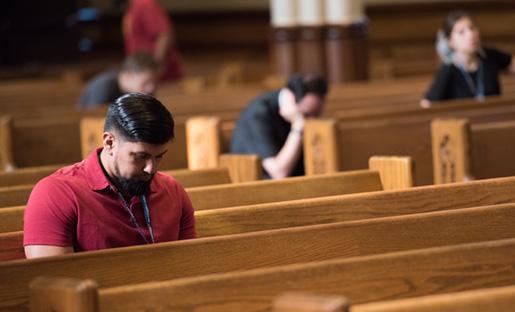
3 minute read
Most Still Struggle to Move from Maintenance to Mission
INTRODUCTION: MOST STILL STRUGGLE TO MOVE FROM MAINTENANCE TO MISSION
I dream of a “missionary option,” that is, a missionary impulse capable of transforming everything, so that the Church’s customs, ways of doing things, times and schedules, language and structures can be suitably channeled for the evangelization of today’s world rather than for her self-preservation.
Advertisement
-Pope Francis1
Most Catholics in the United States have heard the Church’s call to move from maintenance to mission. We’ve experienced the emptying pews, shrinking budgets, and consolidation of parishes first hand. We know people (often in our own families) who have drifted away. In response to these phenomena and the Holy Spirit’s promptings over the last few decades, we’ve heard—through books, parish missions, conferences, podcasts, videos, and social media—how our parishes must move from
1 Pope Francis, Evangelii gaudium, Vatican Website, March 5, 1995, https://www. vatican.va/content/john-paul-ii/en/encyclicals/documents/hf_jp-ii_enc_25031995_ evangelium-vitae.html, sec. 27.
maintenance to mission.2 Virtually everyone, from recent popes to the average parishioner agree on this point.
To this end, parishes spend months devising multi-year pastoral plans. They hire consultants, buy software and video subscriptions. They change job titles and job descriptions to embrace language like “missionary discipleship,” “apostolic mission,” and “evangelization.” But what has been the result? Not much. Sure, there are exceptions. If a parish hires the right person or gets a pastor with enough dynamism, some change happens. Or if they’ve partnered with one of the evangelically focused apostolates that have emerged in the last few decades, like Divine Renovation, Alpha, FOCUS, the Evangelical Catholic, or another one, they’ll likely see positive change. Communities that have or seek to build strong spiritual and human leadership can gain momentum toward becoming mission-oriented. But in my experience, apart from these (thankfully growing) exceptions, most parishes’ attempts fail to produce the hoped-for widespread change.
For all the many years of talk and exhortation, broadly speaking, the Church in the United States (as well as in Europe and other parts of the world), has made only negligible progress moving from a maintenance model to being fully apostolic in our parishes.
The Church . . . has made only negligible progress moving from a maintenance model to being fully apostolic in our parishes.
So how do we help our parishes move from maintenance to mission?
What does it look like to become apostolic? For example, what does a staffing structure at a parish look like, and how does it operate?
2 For example, see: From Maintenance to Mission: Evangelization and the Revitalization of the Parish by Fr. Robert S. Rivers, Divine Renovation: Bringing Your Parish From Maintenance to Mission by Fr. James Mallon, the article “A Call to Discomfort: From Maintenance to Mission” by Catholic Apostolate Center, “The Upper Room” podcast, the “Divine Renovation Podcast.”
What are the top priorities of the pastoral leadership on a dayto-day, week-to-week, and year-to-year basis? What do their job descriptions, schedules, and budgets look like? Moreover, what do the parishioners do in a fully apostolic parish? What is their engagement with the ministries and structures? And why is it so difficult to imagine all of this, especially for those of us who work for the Church?
For all the many questions we could ask about what an apostolic parish looks like, three questions need to be answered first— three questions that create the circumstances for all of the other questions to be answered. Thus, in this paper, we will address:
• What is the end goal of parish ministry?
• Why have we been failing in our attempt to become fully mission-oriented?
• What does a parish need to do to begin a transition from maintenance to mission?






